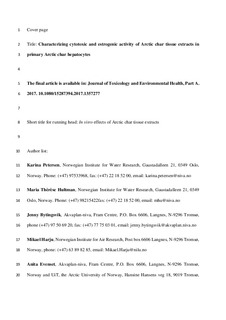Characterizing cytotoxic and estrogenic activity of Arctic char tissue extracts in primary Arctic char hepatocytes
Petersen, Karina; Hultman, Maria Thérése; Bytingsvik, Jenny; Harju, Mikael; Evenset, Anita; Tollefsen, Knut Erik
Journal article, Peer reviewed
Accepted version

Permanent lenke
http://hdl.handle.net/11250/2502182Utgivelsesdato
2017Metadata
Vis full innførselSamlinger
- Publikasjoner fra Cristin - NIVA [2160]
- Scientific publications [1172]
Originalversjon
Journal of Toxicology and Environmental Health. 2017, 80 (16-18), 1017-1030. 10.1080/15287394.2017.1357277Sammendrag
Contaminants from various anthropogenic activities are detected in the Arctic due to long-range atmospheric transport, ocean currents, and living organisms such as migrating fish or seabirds. Although levels of persistent organic pollutants (POPs) in Arctic fish are generally low, local hot spots of contamination were found in freshwater systems such as Lake Ellasjøen at Bjørnøya (Bear Island, Norway). Higher concentrations of organic halogenated compounds (OHC), and higher levels of cytochrome P450 and DNA-double strand breaks were reported in Arctic char (Salvelinus alpinus) from this lake compared to fish from other lakes on Bjørnøya. Although several of the measured contaminants are potential endocrine disrupters, few studies have investigated potential endocrine disruptive effects of the contaminant cocktail in this fish population. The aim of this study was to compare acutely toxic and estrogenic potency of the cocktail of pollutants as evidenced by cytotoxic and/or estrogenic effects in vitro using extracts of Arctic char livers from contaminated Lake Ellasjøen with those from less contaminated Lake Laksvatn at Bjørnøya. This was performed by in situ sampling and contaminant extraction from liver tissue, followed by chemical analysis and in vitro testing of the following contaminated tissue extracts: F1-nonpolar OHC, F2-polar pesticides and metabolites of OHC, and F3-polar OHC. Contaminant levels were highest in extracts from Ellasjøen fish. The F2 and F3 extracts from Lake Laksvatn and Lake Ellasjøen fish reduced in vitro cell viability at a concentration ratio of 0.03–1 relative to tissue concentration in Arctic char. Only the F3 liver extract from Ellasjøen fish increased in vitro vitellogenin protein expression. Although compounds such as estrogenic OH-PCBs were quantified in Ellasjøen F3 extracts, it remains to be determined which compounds were inducing estrogenic effects.
Beskrivelse
This is an Accepted Manuscript of an article published by Taylor & Francis, available online: https://taylorandfrancis.com/. Embargo until 01 September 2018.